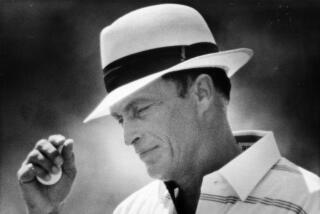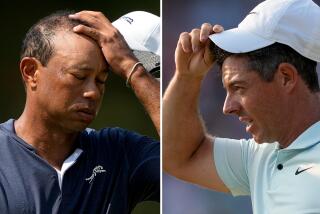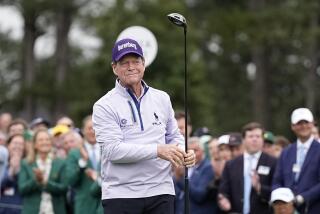Whatâs Wrong With the (Yawn) PGA Tour Today? : Who Are These Guys Who Are Winning Tourneys and What Can Be Done About Them?
WASHINGTON â Professional golf is in a state of severe whiplash. Just nine months ago, when the PGA Tour came to Congressional, the PGA world couldnât have been in better order. Now, it is standing on its head.
Just a blink ago, in June 1985, the old order reigned with confidence and style. The public knew who its heroes were and liked them fine. Reading backward, these were the winners of the previous 13 major golf titles: Bernhard Langer (1985 Masters), Lee Trevino, Seve Ballesteros, Fuzzy Zoeller, Ben Crenshaw, Hal Sutton, Tom Watson, Larry Nelson, Ballesteros, Ray Floyd, Watson, Watson, Craig Stadler (1982 Masters).
In addition, Watson was the leading money-winner in 1984, Jack Nicklaus won his Memorial event in 1984 and rags-to-riches Calvin Peete (1985 TPC) emerged as a popular star with more overall wins (10) in the 1982-to-present period than anybody else. All in all, golf was loaded with marquee appeal and natural story lines.
Holy four-putt, what went wrong?
When Bill Glasson won the Kemper, it felt like a sweet, harmless fluke. Who knew it would demark a trend? A very scary trend.
By the time 1985 was over, look whoâd won: Mark Wiebe, Dan Forsman, Phil Blackmar, Scott Verplank, Ken Green, Joe Sindelar, Roger Maltbie, Jim Thorpe, Tim Simpson and Danny Edwards. The winners of the Open titles of the United States and the United Kingdom: Andy North and Sandy Lyle.
âI figured the big names would be back this season,â said veteran Tom Kite. âMan, was I wrong.â
Here they come. And there they go. Flashes like Glasson who bring the tour the feel of a disorienting whirligig. Maybe someday a couple will prove great. But many are golf chaff. Donnie Hammond, Bob Tway, Doug Tewell, Kenny Knox and (last weekend) Forsman again have won this spring. Also among the top 20 money-winners are more mystery names: Tony Sills, Clarence Rose and Paul Azinger.
New faces are nice. Corey Pavin was a wonderful attraction to add to golf last season. But this is ridiculous. Of the last 33 events, 22 have been won by players whose combined charisma quotient is less than that of whoever happens to be caddying for Nicklaus.
âI sympathize with the public and the press trying to keep up with whoâs winning golf tournaments,â said Kite. âWe do need some names to win, I know that.â
âThe veterans just arenât playing very well. If Iâm having a major slump, theyâre having minor slumps,â Nicklaus said last week. âI donât get very interested (in the no-name winners). Iâm concerned about the continuance of golfâs popularity. We need the stars.
âThis always goes in cycles. Weâre just going through the middle now,â added Nicklaus, who thinks bona fide stars will come out of the current mishmash. In one breath, Nicklaus insisted that golf has never had so many good players. But he didnât use the word âgreat.â
âI donât think there are five outstanding players in golf right now,â he said.
These days, these questions dominate all others on tour:
Who are they? Meaning the new no-names.
Where are they? Meaning superstars Watson, Nicklaus and Ballesteros.
And, above all, why?
SMALL WINNERS
One of golfâs misfortunes is that almost nobody cares about the identity of a man who has won one or two events in his professional life. No matter how charming his tale-of-a-magic-week, itâs written in smoke. And they all start to sound alarmingly similar--at least from a distance.
If youâre Kenny Knox, who won at Eagle Trace this month after getting in the field as a Monday qualifier, your story sounds like nobody elseâs. This man was so broke from chasing the tourâs gypsy life that veteran pro Mac OâGrady recalled, âOnce, Kenny and his wife were sleeping in their car at a tournament site under cellophane to keep warm when a cop found them at dawn and rousted âem.â
Knox had to borrow from a newspaper photographer to give his caddie a little walking-around money until that first-place check for $90,000 could be cashed Monday morning.
Few outside the PGA Tour draw full pleasure from seeing the success this season of gritty people such as Azinger, Tewell and Sills.
âJust a couple of years ago, I played with Azinger when he topped two consecutive drives. We paced âem off. One went 34 yards, the next one 35,â said pro Mark Calcavecchia (thatâs abbreviated Clcvcch in most newspaper lists of agate type). âEven Iâve never topped a drive in a tournament. Paul was so embarrassed and frustrated he talked about quitting the game right there. Itâs inspirational to see him now. He was third one week, second the next.â
Tewell, after a dozen hunt-and-peck years on tour, was about to retire to a club job when he shocked everybody, including himself, by winning the Los Angeles Open.
Nobody on tour since Peeteâs emergence has been surrounded by the good will that accompanies Sills. If he ever wins a big one, look for the major motion picture of his life in your neighborhood theater. Hollywood types are already waiting.
Sills, in the top 10 in cash, has had two major operations because of ulcerative colitis, which he has had for 11 years, since he was 19. At one time, Sills (who also had kidney stones) barely weighed 100 pounds, yet he vowed to be a pro golfer. Six times he failed the PGA Tour qualifying school. Now, heâs up to a steel-hard 150 pounds, does 200 to 300 pushups daily, plus hundreds of situps, and may well double the $125,255 he won last season.
As his example, Sills cites his father, who is 73, has had diabetes for 25 years and has endured going blind, getting cancer, having three heart attacks and a foot amputation.
Why donât these people get more attention?
Because itâs almost impossible to get them into focus. The tour really does have dozens of assembly-line all-Americas with limber backs and swings that have been groomed and grooved since babyhood. You get bonus points if you can match these players with the colleges where they became hotshots: Rose, Tway, Hammond and Forsman. (Answer: Clemson, Oklahoma State, Jacksonville and Arizona State.)
Each of these gentlemen has staunch supporters. The heady Hammond, from Frederick, Md., was qualifying-school medalist by 14 shots in 1982 and has streaks of brilliance. Rose is an erratic power-hitter who was third on tour in birdies (387) last season. Forsman lives by his short game and putting. The 6-foot-4 Tway has such commanding presence that one veteran tour official says, âIn 20 years, weâll be asking, âWhy arenât there more players like Tway anymore?â â
âThese young guys have no fear and they have no bullet holes,â said veteran Joe Inman, trying to explain the stampede of first- or second-time winners.
âTheyâre totally fearless,â moaned Crenshaw. âTheyâre willing to let it all out on every shot.â
THE BIGGER PACK
Part of the reason--maybe the biggest part--is the all-exempt concept instituted by the PGA Tour in 1982. Now, 125 players are fully exempt from weekly qualifying instead of 60, as was the brutal rule for years. âGo back to 60 and then youâll see who can play under pressure,â said Floyd.
In the old days, you could have a fairly presentable season and still miss the top 60. Back to rabbithood. Now, you have to have a major injury or play like a joke to miss the top 125. So, on Saturday and Sunday, more players free-wheel it instead of making sure they cash a decent check. For example, Azinger, Hammond and Rose all would have lost their cards this year under the old rules. Forsman would have lost his twice, in 1983 and 1984.
You say nothing like this has ever happened before? Last season, 11 first-time winners and, now, a bunch more.
Well, in 1968 and again in 1969, there were a dozen first-timers. Ever hear of Trevino and Weiskopf? And, in 1979 and 1980, there were also a dozen new winners each year.
Whatâs different now is the absence of a single great name in the sport. In 1968-69, Nicklaus was king and Arnold Palmer was still winning. In 1979-80, Watson and Nicklaus played the same roles.
OTHER OBLIGATIONS
Now, Nicklaus, who has two wins in five years, both looks and plays old. For the first time, his physique doesnât even look familiar--too much pinch-an-inch waist and too little shoulder and thigh. At 46, the power is finally drained.
âI donât have the time, desire, inclination to do a lot better. I canât live my life that way now,â Nicklaus said last week amid his ever-increasing obligations to a vast business empire. âBut I will play better than this.â
As for Watson, six times player of the year, the tour has been holding its breath for 20 months since his last victory. Last year and this, he has barely cracked the top 20 in money. Under late-round pressure, neither his swing nor his putting has consistently held up.
On the West Coast this year, Watsonâs longtime caddie, Bruce Edwards, made headlines by blowing the whistle on his boss, who has been spending far more of his time being a husband, new father, businessman and course builder.
âWhen we first met, all of his time went into improving his game. Now, he doesnât practice a fifth of the time he used to,â Edwards told The Los Angeles Times.
âYour priorities just become different,â Watson said last week. âItâs not as easy to set your schedule. More things demand attention. Itâs easier to say youâll solve the problem than it is to deal with it in a concrete manner.â
Just as bad as superstar burnout is the question of age and the wayward Watson putter. âIâm just not able to see the lane as easily,â Watson said. âI look at it and say, âIâm just trying to get it close rather than trying to make it.â â
Desire can be rediscovered, but the mystery of sinking an inordinate number of long putts may be lost forever. Nicklaus never lived by the long ones, but Watson, like Palmer, did.
A DISQUALIFICATION
At the very moment when a successor to the Jones, Snead, Hogan, Palmer, Nicklaus, Watson tradition was needed, one seemed to appear--Ballesteros. His possibilities as a drawing card went considerably beyond his major titles (two Masters, two British Opens) and his huge winnings on the weaker world tour. Tall, dark and handsome combined with powerful, daring and moody is box office combustion.
For the first time in modern golf, the legacy of the sportâs leadership role didnât fall to an American. In Europe, Ballesteros got adulation, appearance money and any sort of kingly special treatment he required. And he asked for plenty.
The result? A long petty, nit-picking argument between Ballesteros and the PGA Tour over a minimum appearances schedule that has resulted in his being suspended from the tour for 1986.
Ballesteros, who has been in Spain after the recent death of his father, still was saying the suspension isnât fair as he arrived to make his only 1986 PGA Tour appearance at New Orleans, where he is the defending champion and has been allowed to play.
Even in the Ballesteros case, golf canât catch a break. If Ballesteros had a better track record, heâd have the leverage to make the tour accept him on his terms every week. But he doesnât. Of the last 23 major titles, since the 1980 Masters, Ballesteros has won two. He has never won on any of the tight, tough American courses that require accuracy, patience and the ability to cope with rough--the U.S. Open, PGA or TPC.
VANISHING STARS
And now, as the first watershed events of the golf year approach, the sport of muffled curses is muttering a blue streak. The game that once had a Big Three, then a Big Two, doesnât even have a Big One.
Yet, for the past decade, every time a golf trend has built up enough momentum to be identified, documented and publicized, the darn thing has usually disappeared like the Loch Ness monster on a clear day.
Arnold Palmer will probably win the Masters.
More to Read
Go beyond the scoreboard
Get the latest on L.A.'s teams in the daily Sports Report newsletter.
You may occasionally receive promotional content from the Los Angeles Times.










